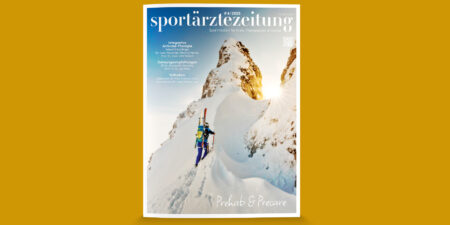Javier Crupnik, Santiago Silveti, Natalia Wajnstein, Alejandro Rolon, Tobias Wuerfel, Peter Stiller, Antoni Morral, John P. Furia, Nicola Maffulli, Christoph Schmitz
The randomised controlled study by Crupnik et al., published in the British Medical Bulletin (Impact Factor 5.4), examines the effectiveness of radial extracorporeal shock wave therapy (rESWT) in combination with a specific rehabilitation programme (RP) for acute type 3b hamstring injuries (according to Müller-Wohlfahrt). It is the first controlled study to confirm an approach that has been established in sports medicine practice and has been systematically implemented and further developed for over a decade at 1. FSV Mainz 05.
Study design and results
In the prospective, blinded RCT, 36 semi-professional athletes (football, hockey, rugby) with a type 3b hamstring injury were treated. The intervention group received rESWT (3 times per week, DolorClast, EMS) in addition to a structured rehabilitation programme lasting up to 8 weeks. The control group received sham rESWT with an identical rehabilitation protocol.
- Return to sport: Ø 25.4 ± 3.5 days (rESWT+RP) vs. 28.3 ± 4.5 days (sham rESWT+RP), p = 0.037
- Isometric strength deficits compared to the opposite side after therapy only in the control group
- Both groups had similar satisfaction scores and only one patient from each group suffered a re-injury during the six-month follow-up period.
Clinical relevance
The study proves that the combination of rESWT and a structured rehabilitation programme significantly reduces the time it takes to return to sport and is more effective at preventing functional deficits than rehabilitation alone. Against the backdrop of Müller-Wohlfahrt’s international classification system, this study is the first to examine evidence-based therapy for the common type 3b injury under controlled conditions.
Conclusion
The published study data confirm a treatment concept that has been proven over many years. The integrative use of rESWT within a functional rehabilitation structure offers an evidence-based approach to reducing the duration of rehabilitation and avoiding post-traumatic deficits. rESWT has by no means replaced physiotherapy and the rehabilitation programme, but rather complemented them in a meaningful way. Structured training in the application of physical therapies – in the sense of guided medical education – remains essential to ensure the long-term clinical quality of these procedures.
The complete study can be found HERE
Autoren
ist Inhaber des Lehrstuhls II der Anatomischen Anstalt der Ludwig-Maximilians Universität München und wissenschaftlicher Beirat der sportärztezeitung.




